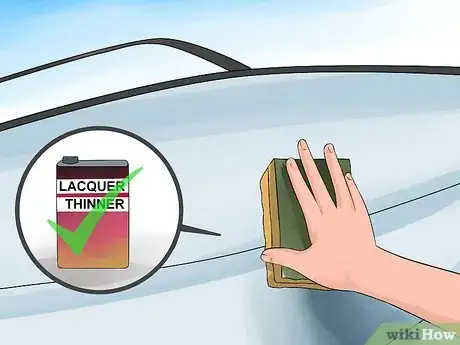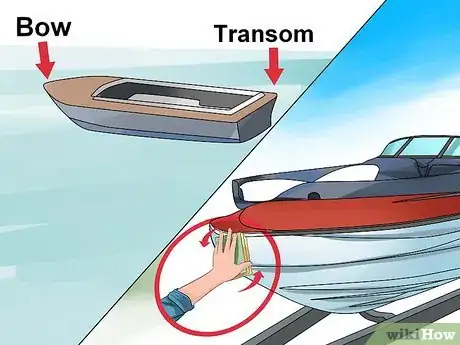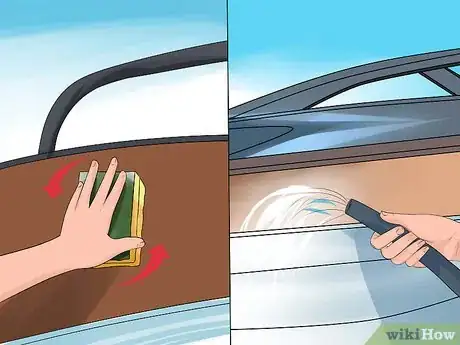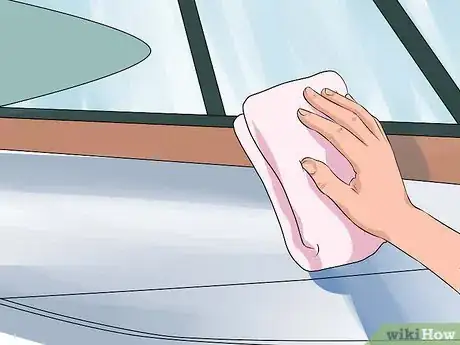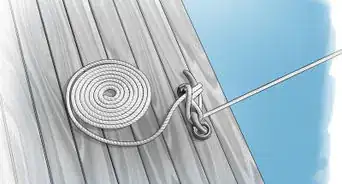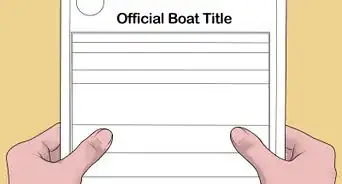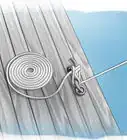This article was co-authored by Travis Lund. Travis Lund is the General Manager at the Vallejo Marina, a large marina located between the San Francisco Bay and the Delta in California. Sailing since he was six-years-old, Travis has over 15 years working in sailing operations and instruction and has pioneered a coaching platform that combined traditional coaching with multi-camera video support. He studied English at Michigan State University, where he was on the sailing team.
wikiHow marks an article as reader-approved once it receives enough positive feedback. In this case, 100% of readers who voted found the article helpful, earning it our reader-approved status.
This article has been viewed 187,307 times.
Your boat’s fiberglass gelcoat will maintain its high gloss for a long time if you keep it clean, waxed and stored out of the sun. If the surface has started to discolor or dull, or if the gelcoat has been subjected to a lot of wear and tear, you’ll need to learn how to buff a boat. Although the process is basically simple, and not much different from buffing a car, every boat owner has a unique take on it. This article explains the basic steps in buffing a boat.
Steps
Washing the Boat
-
1Position the boat on the trailer securely. Boats should be waxed out of the water, secured on the trailer, preferably parked on a flat, even surface. Because you'll be spraying products and moving all around the boat, you'll probably not want to have the trailer attached to your car, either.[1]
- Depending on the style of your boat, you'll probably want to put the cover on before you get started waxing and cleaning the boat. To keep the interior safe, keep the cover on.
-
2Hose down the exterior of the boat first. It’s important to only wax a recently-cleaned boat, so remove all loose dirt and grime, as well as algae buildup and other gunk, especially if the boat’s been sitting in the water.[2]
- Start with plain water, spraying evenly across the surface of the exterior that needs to be cleaned. Use a clean, wet sponge to start scrubbing gently and get the grime running off.
- If there are really serious spots of build-up, you can use some fine-grain 220 sandpaper to clean it off. Don't use a power washer on your boat, which can damage the finish and affect the efficacy of the gelcoat. Use a gentle spray, as opposed to a powerful spray.
Advertisement -
3Clean the old wax from the surface. Use rags soaked with toluene or another dewaxing solvent to remove traces of old wax, which can keep polish and rubbing compounds from working evenly across the surface of the boat.
- Sweep the rag in one direction, applying light pressure. It's not something you should usually have to scrub very hard to remove. Allow the solvent to evaporate before buffing.
-
4Wash with a proper detergent. Finish washing the surface with a sponge and special boat soap or a mild solution of dishwashing detergent and warm water.[3]
- If the surface of your boat is stained, it's sometimes common to use a small amount of bleach to disinfect and clean thoroughly. It's also sometimes common to use lacquer thinner, Varsol or a special degreaser to remove sticky adhesive spots or greasy buildup. Don't use bleach on untreated or unstained wooden boats.
- Rinse the boat thoroughly with clean water and allow to dry. You can use a squeegee to speed up the drying process, if necessary.
Buffing the Surface of the Boat
-
1Consider using a polish or buffing compound. Both polish and buffing compound are abrasives, which restore the shine to your boat’s fiberglass gelcoat by removing imperfections, discolorations and scrapes in the surface, increasing the reflective shine.[4] [5]
- Choose polish if your boat only needs light refinishing. Go with a stronger rubbing compound if the surface is excessively pitted or chalky, signs that the surface needs a much more substantial cleaning.
- Be very careful when using a rubbing compound. Gelcoat is extremely thin and an aggressive compound can burn through it quickly, necessitating an expensive and time-consuming repair job.
-
2Begin at the transom and work toward the bow. Work in sections about 2 feet (0.610 meters) square to apply the rubbing compound or polish. Use a soft cloth if you’re working by hand, or fit the buffer with a foam polishing pad. Apply a circle of polish or buffing compound to the cloth or pad and rub it into the surface using a steady, even, circular motion. Buff until the surface becomes glassy looking. If you can see through the gelcoat, you’ve gone too far.
- Some purists swear by hand buffing, while others argue that using a tool saves your muscles and helps eliminate streaks and swirls. Choose a low-speed buffer, not a high-speed sander, for better control. Tools with an orbital motion are less likely to leave swirling streaks.
- If you’re using a buffer, start at the slowest speed. Touch the pad lightly to the surface before starting the buffer so the polish or compound doesn’t spray in all directions.
-
3Follow up use of a buffing compound by applying polish. If necessary, apply polish using the same method. Use circular motions and move in the same direction you moved when applying the rubbing compound. Hose off the boat and the work area to remove the dust raised by the polishing and compounding.
Waxing the Boat
-
1Choose an appropriate variety of boating wax. The variety of boating wax you use will vary, depending on the style and the surface of your boat's gelcoat. Keeping gelcoat coated with wax can help the gelcoat maintain its shine for a long time, offering a protective buffer between the coat and the water.
- Collinite 885 is a commonly used and recommended boating wax, used also in surfing and for other purposes.
-
2
-
3Exercise care around fittings and in tight spaces. Regardless of whether you use an electric buffer or a hand buffer, work by hand around non-removable fittings to keep the buffer from catching on or damaging them. Do the same in tight crevices.
- Remove fittings ahead of time if possible, keeping the screws with the fixtures closely, so you won't get confused later.
-
4Allow the wax to dry. After a small amount of time, the wax should start to look somewhat hazy, which means you're ready for a second buffing. It's important to allow the wax enough time to set, so it'll be able to protect the gelcoat. This should only take 5-10 minutes in the sun.[7]
-
5Buff the wax to a shine. Use a soft towel or terrycloth bonnet if you decide to use an electric polisher, or a clean hand buffer and work in circles. The shine should really start to pop as you buff away the cloudiness of the wax.
- Try to buff out the wax in small sections.[8]
Expert Q&A
-
QuestionHow can you restore boat gel coat?
 Travis LundTravis Lund is the General Manager at the Vallejo Marina, a large marina located between the San Francisco Bay and the Delta in California. Sailing since he was six-years-old, Travis has over 15 years working in sailing operations and instruction and has pioneered a coaching platform that combined traditional coaching with multi-camera video support. He studied English at Michigan State University, where he was on the sailing team.
Travis LundTravis Lund is the General Manager at the Vallejo Marina, a large marina located between the San Francisco Bay and the Delta in California. Sailing since he was six-years-old, Travis has over 15 years working in sailing operations and instruction and has pioneered a coaching platform that combined traditional coaching with multi-camera video support. He studied English at Michigan State University, where he was on the sailing team.
Sailing Instructor & Executive Director, Treasure Island Sailing Center Gel coats can be restored with a simple, 3-step process: heavy compound, finishing compound, and wax.
Gel coats can be restored with a simple, 3-step process: heavy compound, finishing compound, and wax. -
QuestionWhy do you polish a boat?
 Travis LundTravis Lund is the General Manager at the Vallejo Marina, a large marina located between the San Francisco Bay and the Delta in California. Sailing since he was six-years-old, Travis has over 15 years working in sailing operations and instruction and has pioneered a coaching platform that combined traditional coaching with multi-camera video support. He studied English at Michigan State University, where he was on the sailing team.
Travis LundTravis Lund is the General Manager at the Vallejo Marina, a large marina located between the San Francisco Bay and the Delta in California. Sailing since he was six-years-old, Travis has over 15 years working in sailing operations and instruction and has pioneered a coaching platform that combined traditional coaching with multi-camera video support. He studied English at Michigan State University, where he was on the sailing team.
Sailing Instructor & Executive Director, Treasure Island Sailing Center Gel coat is pretty porous, and it tends to oxidize. Applying polish prevents the gel coat from flaking into a powdery substance that comes off on your clothes and hands. Plus, polish helps reflect light and prevents damage from the sun.
Gel coat is pretty porous, and it tends to oxidize. Applying polish prevents the gel coat from flaking into a powdery substance that comes off on your clothes and hands. Plus, polish helps reflect light and prevents damage from the sun. -
QuestionHow do I go about waxing a boat that is badly faded and hasn't been waxed in about 6 or 8 years?
 Aloha27Community AnswerYou're in for a tough slog here. Great care must be taken, as using an aggressive compound can easily blast through the thin layer of gelcoat resulting in an expensive repair. I would use a combination cleaner/wax (such as 3M).
Aloha27Community AnswerYou're in for a tough slog here. Great care must be taken, as using an aggressive compound can easily blast through the thin layer of gelcoat resulting in an expensive repair. I would use a combination cleaner/wax (such as 3M).
Warnings
- Always work in a well ventilated area and use protective gear, such as gloves, eye coverings and a mask or ventilator.⧼thumbs_response⧽
Things You’ll Need
- Boat soap or detergent
- Acetone
- Toluene or wax remover
- Sponges and rags
- Protective gear
- Fiberglass polish formulated for boats
- Rubbing compound, if necessary
- Orbital buffer, if used
- Soft cloths or foam buffing pads
- Boat wax
- Soft towels
References
- ↑ http://www.boatlife.com/news/boat-waxing-a-simple-guide-for-firsttimers/
- ↑ https://www.practical-sailor.com/blog/waxing_polishing_boat-10430-1.html
- ↑ http://sailingmagazine.net/article-868-washing-and-waxing.html
- ↑ http://transomfix.dcpolk.com/Home-1/buffing-fiberglass
- ↑ Travis Lund. Sailing Instructor & Executive Director, Treasure Island Sailing Center. Expert Interview. 24 April 2020.
- ↑ Travis Lund. Sailing Instructor & Executive Director, Treasure Island Sailing Center. Expert Interview. 24 April 2020.
- ↑ https://magicezy.com/how-to-wax-your-fiberglass-boat/
- ↑ Travis Lund. Sailing Instructor & Executive Director, Treasure Island Sailing Center. Expert Interview. 24 April 2020.
About This Article
To wax your boat, start by rubbing it with a rag soaked in a dewaxing solvent to remove any traces of the old wax. You should also wash it with a sponge and boat soap to get rid of any dirt or debris. Once your boat’s clean, use a polish or buffing compound and a soft cloth to remove any imperfections in the surface. After you’ve buffed the surface, apply your wax with a hand or electric buffer. Use circular motions to avoid leaving any streaks in the finish. While you’re waxing around fittings and tight spaces, slow down and be careful so you don’t damage them. When you’ve finished waxing the whole surface, leave it to dry for 5-10 minutes. Then, buff the wax with a soft towel or terrycloth to bring out its shine. For more tips, including how to choose a good wax product for your boat, read on!



